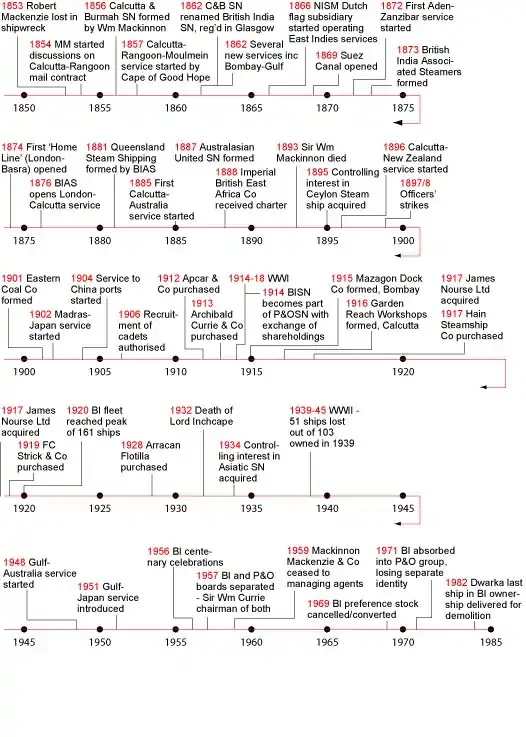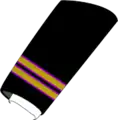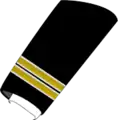 | |
 | |
| Type | ship owner and ship operator |
|---|---|
| Industry | transport |
| Founded | 1856 |
| Defunct | 1972 |
| Successor | P&O |
| Products | passenger and cargo shipping |
| Parent | P&O (1914 onwards) |
| Website | http://www.poheritage.com/our-history/company-guides/british-india-steam-navigation-company |
British India Steam Navigation Company ("BI") was formed in 1856 as the Calcutta and Burmah Steam Navigation Company.
History
The Calcutta and Burmah Steam Navigation Company had been formed out of Mackinnon, Mackenzie & Co, a trading partnership of the Scots William Mackinnon and Robert Mackenzie, to carry mail between Calcutta and Rangoon. It became British India SN Co in 1862. Under the hand of Lord Inchcape, who had become chairman in 1913, the company became part of the P&O group of companies in 1914 through a complex amalgamation, but continued with its own identity and organisation for another nearly 60 years until 1972, when it was entirely absorbed into P&O.
Fleet and routes
As one of the largest shipowners of all time, the company owned more than 500 ships and managed 150 more for other owners. At its height in 1922, BI had more than 160 ships in the fleet, many built on Clydeside, Scotland. The main shipping routes of the line were: Britain to India, Australia, Kenya, Tanganyika. The company ran services from India to Pakistan, Ceylon, Bay of Bengal, Singapore, Malaya, Java, Thailand, Japan, Persian Gulf, East Africa and South Africa. BI had a long history of service to the British and Indian governments through trooping and other military contracts. In the last decade of its operational existence BI carried thousands of school children on educational cruises.
Mantola was sunk in February 1917 by a torpedo from a German submarine off the coast of Ireland with a substantial cargo of silver bullion.
The cargo ship Gairsoppa, carrying silver bullion, pig iron and tea, which was sunk at great depth by the German submarine U-101 in February 1941 some 300 nautical miles (560 km; 350 mi) southwest of Galway Bay, Ireland, carried the richest cargo of any sunken ship in world history.[1]
Some of the company's better known passenger ships included Rajula, Dunera, Scindia, Sirdhana, Leicestershire, Dwarka, Dumra, the sister ships Kampala and Karanja, and Kenya and Uganda, and Dara, which was sunk by a terrorist bomb in 1961.
Nevasa of 1956 was the final passenger ship built for BI. Serving as a troopship until redundant in 1962, Nevasa was assigned new duties with the BI educational cruise ship flotilla until 1974, when she became uneconomic[2] due a four fold increase in crude oil prices and was scrapped in 1975 having earlier been joined in this trade by the more economic Uganda. The highly popular Uganda was taken up (STUFT) by the British Ministry of Defence in 1982 as a hospital ship during the Falklands war with Argentina. Returning to BI's tradition of government service again in 1983 – this time as a troopship – Uganda was "the last BI" when finally withdrawn in 1985. Dwarka holds the distinction of closing British-India's true "liner" services, when withdrawn from the company's Persian Gulf local trades in 1982, in her 35th year.
Company timeline

Rank badges of ship's complement
 Commander
Commander Chief Officer
Chief Officer
with superior certificate Chief Officer
Chief Officer
with certificate of rank Second Officer
Second Officer
with superior certificate Second Officer
Second Officer
with certificate of rank Third Officer
Third Officer
with certificate of rank Fourth Officer
Fourth Officer
with certificate of rank Third & Fourth Officer
Third & Fourth Officer
without certificate Cadet
Cadet
 Chief Engineer Officer
Chief Engineer Officer Second Engineer Officer
Second Engineer Officer
with superior certificate Second Engineer Officer
Second Engineer Officer
with certificate of rank Third Engineer Officer
Third Engineer Officer
with certificate Third Engineer Officer
Third Engineer Officer Fourth Engineer Officer
Fourth Engineer Officer Junior Engineer Officer
Junior Engineer Officer
 Senior Electrician
Senior Electrician Second Electrician
Second Electrician Junior Electrician
Junior Electrician
 Senior Purser
Senior Purser Purser
Purser Assistant Purser
Assistant Purser
 Chief Steward
Chief Steward Second Steward
Second Steward Extra Second Steward
Extra Second Steward
 Doctor
Doctor Nursing Sister
Nursing Sister Matron
Matron Assistant Matron
Assistant Matron
Source: [3]
References
- ↑ C. Michael Hogan. 2011
- ↑ "Ship Fact Sheet - Nevasa (1956)" (PDF). P&O Heritage. Retrieved 20 September 2020.
- ↑ BIShip. 2022-09-01.
External links
- BI Ship Site
- A Short History of British India Steam Navigation
- Clydeside built BI ships
- Miller, William H., The Last Blue Water Liners, Conway Press, London, 1986 - ISBN 0-85177-400-8
- Morton, Michael Quentin, "The British India Line in the Arabian Gulf, 1862-82", Liwa journal, December 2013, Vol. 5, No. 10, pp. 40–63
- Documents and clippings about British India Steam Navigation Company in the 20th Century Press Archives of the ZBW
